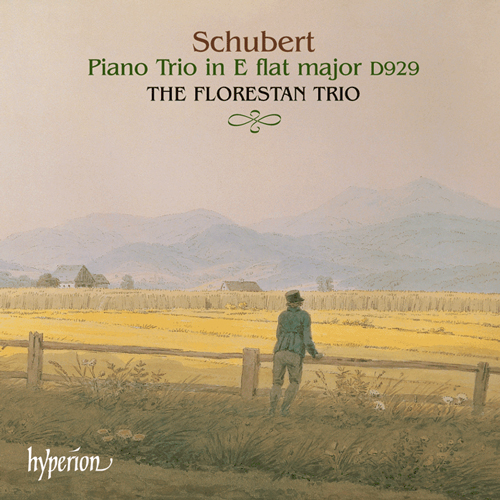Schubert Piano Trio in E flat
A splendidly characterised performance proves an excellent follow-up to the Florestan Trio’s previous Schubert CD
View record and artist detailsRecord and Artist Details
Composer or Director: Franz Schubert
Genre:
Chamber
Label: Hyperion
Magazine Review Date: 11/2002
Media Format: CD or Download
Media Runtime: 58
Mastering:
Stereo
DDD
Catalogue Number: CDA67347

Tracks:
| Composition | Artist Credit |
|---|---|
| Piano Trio No. 2 |
Franz Schubert, Composer
Florestan Trio Franz Schubert, Composer |
Author: DuncanDruce
Rather as Schubert himself did in the closing months of 1827, the Florestan Trio swiftly follow their illuminating account of the B flat Trio (Hyperion, 3/02) with the more profound, yet still often light-hearted E flat Trio. This was written in the same month (November) that Schubert completed Winterreise. We are instantly reminded of this in the Florestan’s eloquent and aptly paced account of the C minor Andante con moto, with what Richard Wigmore describes as its ‘stoical trudging gait’. Its essential melancholy is gently caught, first by the cellist, Richard Lester, and then equally touchingly by the pianist, Susan Tomes (0'56").
The dramatically rhythmic opening of the first movement (like the B flat Trio before it) could almost be by Beethoven, but once again these players show themselves to be completely within the Schubertian sensibility and catch perfectly the atmosphere of the more important lyrical motif, first heard on the cello (in bars 15 and 16), which is to dominate the movement alongside the engaging repeated-note figure (so delicately articulated by the piano (1'00"). You can easily pick these ideas out, for the performance includes the exposition repeat.
The canonic Minuet/Scherzo is genially Viennese and is handled here with a remarkably wide dynamic range, with the Trio agreeably boisterous, yet with contrasting moments of intimacy when the repeated-note theme from the first movement reappears. They then winningly set a jaunty mood for the finale, which is maintained whenever the main theme reappears, even though, as always with late Schubert, much happens to vary the music’s mood and atmosphere including the reprise of the main cello theme from the slow movement, brightly decorated by the violin and piano. Schubert must have had a very soft spot for this melody, as it comes back again in the coda, which ends the work so positively. Another superb performance then, penetrating, yet full of spirited spontaneity, and in spite of the moments of sadness, much Schubertian bonhomie. As before, the recording is completely lifelike and very well balanced.
As a bonus we are offered Schubert’s original finale, nearly two minutes longer without the two cuts in the development made by the composer, totalling 98 bars. But Schubert was right: there may be a case for the extra ‘heavenly’ length, but the finale normally heard seems to me just right. With the benefit of CD you can make your own judgement.
The dramatically rhythmic opening of the first movement (like the B flat Trio before it) could almost be by Beethoven, but once again these players show themselves to be completely within the Schubertian sensibility and catch perfectly the atmosphere of the more important lyrical motif, first heard on the cello (in bars 15 and 16), which is to dominate the movement alongside the engaging repeated-note figure (so delicately articulated by the piano (1'00"). You can easily pick these ideas out, for the performance includes the exposition repeat.
The canonic Minuet/Scherzo is genially Viennese and is handled here with a remarkably wide dynamic range, with the Trio agreeably boisterous, yet with contrasting moments of intimacy when the repeated-note theme from the first movement reappears. They then winningly set a jaunty mood for the finale, which is maintained whenever the main theme reappears, even though, as always with late Schubert, much happens to vary the music’s mood and atmosphere including the reprise of the main cello theme from the slow movement, brightly decorated by the violin and piano. Schubert must have had a very soft spot for this melody, as it comes back again in the coda, which ends the work so positively. Another superb performance then, penetrating, yet full of spirited spontaneity, and in spite of the moments of sadness, much Schubertian bonhomie. As before, the recording is completely lifelike and very well balanced.
As a bonus we are offered Schubert’s original finale, nearly two minutes longer without the two cuts in the development made by the composer, totalling 98 bars. But Schubert was right: there may be a case for the extra ‘heavenly’ length, but the finale normally heard seems to me just right. With the benefit of CD you can make your own judgement.
Explore the world’s largest classical music catalogue on Apple Music Classical.
Included with an Apple Music subscription. Download now.

Gramophone Digital Club
- Digital Edition
- Digital Archive
- Reviews Database
- Events & Offers
From £9.20 / month
Subscribe
Gramophone Club
- Print Edition
- Digital Edition
- Digital Archive
- Reviews Database
- Events & Offers
From £11.45 / month
Subscribe
If you are a library, university or other organisation that would be interested in an institutional subscription to Gramophone please click here for further information.






